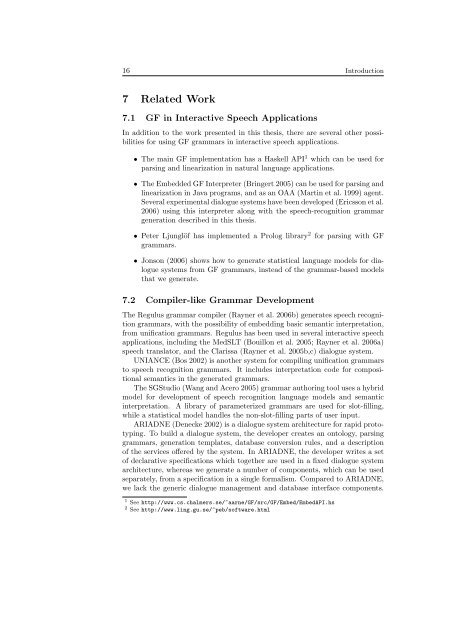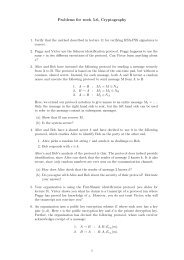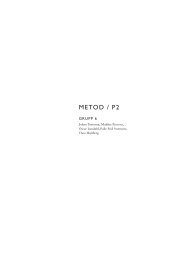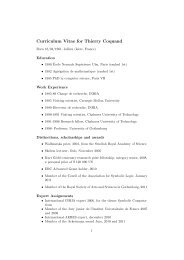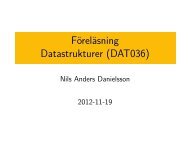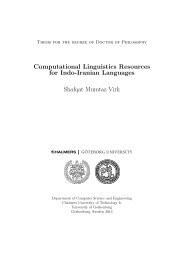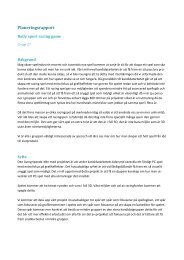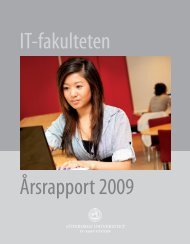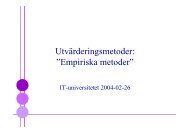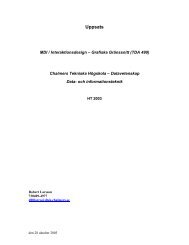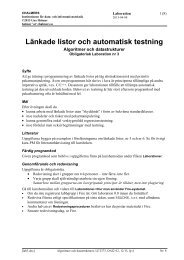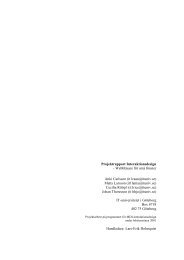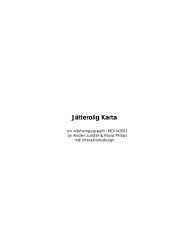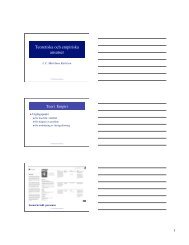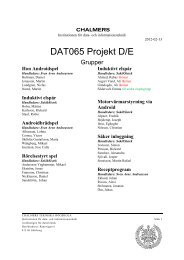Compiling Grammar-based Speech Application ... - CiteSeerX
Compiling Grammar-based Speech Application ... - CiteSeerX
Compiling Grammar-based Speech Application ... - CiteSeerX
You also want an ePaper? Increase the reach of your titles
YUMPU automatically turns print PDFs into web optimized ePapers that Google loves.
16 Introduction<br />
7 Related Work<br />
7.1 GF in Interactive <strong>Speech</strong> <strong>Application</strong>s<br />
In addition to the work presented in this thesis, there are several other possibilities<br />
for using GF grammars in interactive speech applications.<br />
• The main GF implementation has a Haskell API 1 which can be used for<br />
parsing and linearization in natural language applications.<br />
• The Embedded GF Interpreter (Bringert 2005) can be used for parsing and<br />
linearization in Java programs, and as an OAA (Martin et al. 1999) agent.<br />
Several experimental dialogue systems have been developed (Ericsson et al.<br />
2006) using this interpreter along with the speech-recognition grammar<br />
generation described in this thesis.<br />
• Peter Ljunglöf has implemented a Prolog library 2 for parsing with GF<br />
grammars.<br />
• Jonson (2006) shows how to generate statistical language models for dialogue<br />
systems from GF grammars, instead of the grammar-<strong>based</strong> models<br />
that we generate.<br />
7.2 Compiler-like <strong>Grammar</strong> Development<br />
The Regulus grammar compiler (Rayner et al. 2006b) generates speech recognition<br />
grammars, with the possibility of embedding basic semantic interpretation,<br />
from unification grammars. Regulus has been used in several interactive speech<br />
applications, including the MedSLT (Bouillon et al. 2005; Rayner et al. 2006a)<br />
speech translator, and the Clarissa (Rayner et al. 2005b,c) dialogue system.<br />
UNIANCE (Bos 2002) is another system for compiling unification grammars<br />
to speech recognition grammars. It includes interpretation code for compositional<br />
semantics in the generated grammars.<br />
The SGStudio (Wang and Acero 2005) grammar authoring tool uses a hybrid<br />
model for development of speech recognition language models and semantic<br />
interpretation. A library of parameterized grammars are used for slot-filling,<br />
while a statistical model handles the non-slot-filling parts of user input.<br />
ARIADNE (Denecke 2002) is a dialogue system architecture for rapid prototyping.<br />
To build a dialogue system, the developer creates an ontology, parsing<br />
grammars, generation templates, database conversion rules, and a description<br />
of the services offered by the system. In ARIADNE, the developer writes a set<br />
of declarative specifications which together are used in a fixed dialogue system<br />
architecture, whereas we generate a number of components, which can be used<br />
separately, from a specification in a single formalism. Compared to ARIADNE,<br />
we lack the generic dialogue management and database interface components.<br />
1 See http://www.cs.chalmers.se/~aarne/GF/src/GF/Embed/EmbedAPI.hs<br />
2 See http://www.ling.gu.se/~peb/software.html


